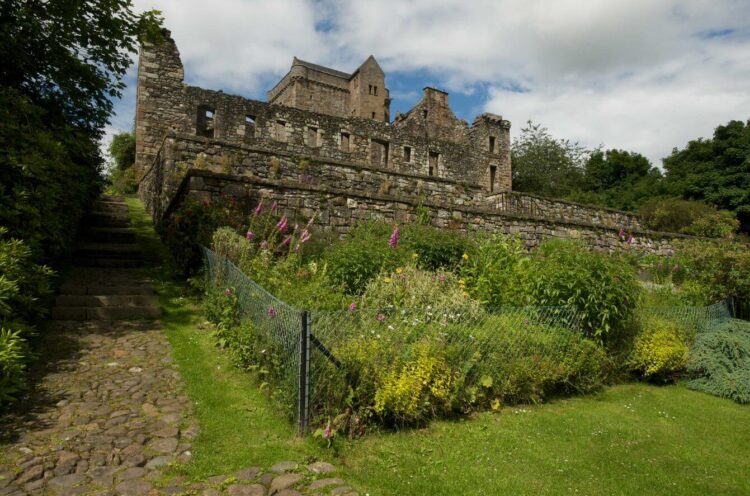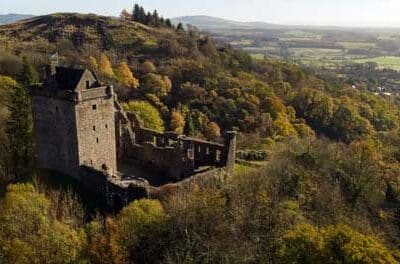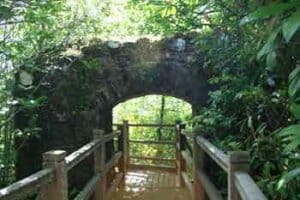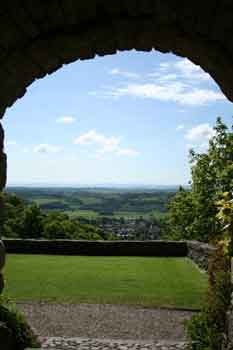
Castle Campbell, Only a dozen or so miles from Stirling, was once home to the Campbell earls of Argyll.
Castle Campbell one of the most evocative castles in Scotland stands on a narrow ridge in the Ochil Hills flanked by a deep ravine on each side.
The curiously named Burn of Care flows at the bottom on one side, with the Burn of Sorrow on the other.
The history of Castle Campbell
The castle was originally known as Castle Gloom, possibly a derivation of the Gaelic ‘gloume’, meaning chasm. A close inspection of the castle provides signs that suggest an even earlier structure. Historians argue it could have been similar to others established in Scotland by Anglo-Norman and Flemish settlers in the 12th century.
Castle Gloom
By that time, Colin Campbell, the first Earl of Argyll owned the castle, acquiring it through the marriage (c. 1465) to Isabel, the eldest daughter of John Stewart, 3rd Lord Lorne.
The first documentary evidence of the castle comes in a Papal Bull dated 1466. This document directed the church against Walter Stewart of Lorne for his destruction of a, “certain manor with a tower of the Place of Glowm in the territory of Dollar.”
Campbell was part of a clan that grew to be one of the richest and most powerful in Scotland, and no story of Castle Campbell, their Lowland stronghold, is complete without mention of the family most associated with it.
In 1457, James II made Campbell the Earl of Argyll, an honour bestowed in recognition of his role as a crown agent in the countryside bordering the recalcitrant MacDonald Lordship of the Isles. It was the only territorial earldom created by James.
Later, under James III, Campbell became Lord High Chancellor of Scotland and one of the commissioners sent to France to renew the special relationship between Scotland and France known as the Auld Alliance.
University of St Andrews
Although Castle Gloom proved to be a fitting residence for such an important and influential man, Campbell wanted it to bear his own name.
Parliamentary records, collated from original sources by the University of St Andrews, show the change of name from Castle Gloom to Castle Campbell.
The records said, “Our sovereign lord, by his royal authority, at the request and supplication of his cousin and trusted councillor Colin [Campbell] Earl of Argyll, Lord Campbell and Lorne
“his chancellor, has changed the name of the castle and place which was called the Gloume pertaining to his said cousin, and in this, his present parliament alters and changes the said name and ordains the same castle to be called Campbell in the future.”

Archibald, the 2nd Earl (rather confusingly many of the following earls of Argyll were also called Archibald), succeeded his father in May 1493 and added the south range to the castle.
With its impressive state apartments on the first floor, the south range was often favourably compared to the King’s Old Building at Stirling Castle.
The second earl is also credited with the construction of the beautiful terraced gardens that stretch out below the south range.
Like his father, Archibald Campbell was a powerful and influential figure in Scotland. During the reign of James IV, he became Master of the Royal Household (a title still held by the current Duke of Argyll).
He died along with the king and many other Scottish nobles at the Battle of Flodden in September 1513.
The 4th Earl, also Archibald, campaigned for religious reform in Scotland, in his later life converting to Protestantism.
If some sources are to be believed, the conversion may have taken place as early as 1536, when Campbell accompanied James V to France for his daughter’s wedding to Madeline the French king’s daughter.
In addition to his other state responsibilities, Campbell became a member of the regency council tasked with leading the country after James V’s death in 1542.
Castle Campbell & John Knox
In October 1555, Campbell met John Knox, who was on a clandestine tour of Scotland. It’s fair to say that he was profoundly influenced by the radical preacher.

By May of the following year, despite the attempts to persuade him to stay, Knox decided to return to Geneva. He did, however, stay a few extra days at Castle Campbell where he preached and possibly celebrated communion.
Tucked away in a secluded spot at the bottom of the castle gardens in an area now called John Knox’s pulpit, which may or may not be the site of the sermon.
Campbell’s commitment to the Protestant cause was such that only months before he died in November 1558, he was one of the first signatories to the first band of the Protestant Congregation in Scotland.
The document called for a reformation of the church according to Protestant principles and its signatories were known as the Lords of the Congregation of Christ.
Castle Campbell: Dollar Glen
Mary Queen of Scots was another high-profile visitor to this most dramatic of Scottish castles. Only recently recovered from illness, she arrived in Dollar Glen on 9 January 1563, staying at the castle for just a few days.
She was there to attend the wedding of her distant relative James Stewart, Lord Doune to Margaret, the 5th Earl’s sister.
Antonia Fraser’s Mary Queen of Scots gives us the briefest hint of some of the wedding festivities. In a series of masques or entertainments, “shepherds appeared wearing white damask and playing sweetly upon the lute.”
More Scottish history articles
Around 1590, Archibald the 7th Earl made substantial changes to the castle. Most notable was the work on the east range where he rebuilt the courtyard elevation, adding an unusual two-arch loggia. Historic Environment Scotland (HES) describes it as a “sophisticated piece of design.”
Included within the structure are two corridors that give access to other parts of the castle. Although HES are emphatic that they were not mere passageways, but galleries – one on the top floor and the second below.
It was a place where the family could admire portraits hanging on the walls. They were, according to HES, “The origin of today’s portrait galleries.”
Argyll Charter Chest
Contemporary students of Campbell history are indebted to the unknown administrators who compiled a castle inventory for the 7th Earl in February 1595.
Found in what became known as the Argyll Charter Chest, the inventory provided a window into daily life in the castle. Room by room, it lists the ‘inspreich’ and ‘geir’ (furnishings and property) of each.
Totalling six pages, in a difficult to read handwriting, the inventory notes the existence of everything from iron chimneys and grates to table covers, valuable tapestries and pieces of armour.
There was too “fine crimson velvet Mass cloth embroidered with gold,” indicating the existence of a chapel {prior to the Reformation of 1560}.
Campbell history inventory
Bearing in mind the family’s support for the Protestant religion, it was entirely predictable that they and their castle were engulfed in the political and religious upheaval that marked life in 17th century Scotland.
Indeed, the celebrated naturalist and writer Thomas Pennant noted in A Tour in Scotland (1769) that Castle Campbell, “underwent all the calamities of the civil war in 1645… when the Marquis of Montrose carried fire and sword through the whole estate.”
While there is little doubt that times were indeed very difficult, there is now some debate about how badly damaged the castle actually was. HES reports that, “the castle remained in Covenanter’s hands apparently little damaged.”
Horace Walpole and James Boswell
It’s an interesting conclusion that raises questions about the reliability of Pennant’s sources. Although his work received critical acclaim, both Horace Walpole and James Boswell considered his writing diminished by his reliance on others’ information.
On the other hand, Pennant was not alone in his assessment. John Buchan in his biography of Montrose wrote “… then came the news that the grim tower of Castle Campbell, an Argyll possession, had been sacked and burned.”
It’s known that the damage to the nearby villages of Dollar and Muckhart was considerable and very real.
The people of Dollar who sought financial compensation from Parliament told of, “whole houses… burnt, their corn destroyed… by enimies of this kirk and kingdome in the rebellioun of James Grahame [Montrose] and bloodie Irishes with him.”
That they were difficult times can be seen in the shifting allegiances of Archibald, the 8th Earl and 1st Marquis. A signatory to the National Covenant in 1638 he swung between the ranks of Covenanters and Royalists.
In those violent times, his wasn’t unusual of course, as powerful nobles sought, in whichever way they could, either to further their political ambitions or, in many cases, merely to survive.
Oliver Cromwell
Despite Oliver Cromwell’s defeat of a Scottish army at Dunbar in September 1650, Campbell crowned Charles II King of Scots in a belated ceremony at Scone the following year.
However, not long after he sensed the political wind shifting and joined others to proclaim Cromwell as Lord Protector of Scotland.

In 1653, a letter from, Colonel Lilburne to Cromwell said, “Hee [Campbell] promises to use his endeavour to his utmost power to preserve peace and upon his return from Castle Cammel, which will be shortly, he will send for some of these new engagers [alliance of moderate Covenanters and Royalists] and try if he can convince them of their follie.”
By the end of the year, English soldiers garrisoned Castle Campbell.
The final days for Castle Campbell as a defensive structure and family home came in September 1654 when General George Monk, Cromwell’s commander-in-chief in Scotland, burned the castle.
In a letter written from Stirling on 29 July and addressed to Cromwell, Monk said, “Wee are now come hither where we will stay for refreshment. Some small parties of the Enemy are abroad in the country and on Monday and Tuesday Nights last, burnt Castle Campbell, an House belonging to the Marquis of Argyll.”
More than 300 years later, in 1982, archaeologists discovered charred timbers in the floor and joists in the hall and state apartments – tangible evidence of Monk’s work.
Restoration of Charles II
Following Cromwell’s death in 1658 and the restoration of Charles II to the throne in 1660, Campbell was charged with treason and imprisoned in Edinburgh Castle.
He was beheaded on 27 May 1661, and his titles were forfeited. (In 1663 however, the earldom – but not the marquisate – was restored to the son, Archibald Campbell).
Today Historic Environment Scotland manages the castle, while the National Trust for Scotland maintains the surrounding Dollar Glen which is a Site of Special Scientific Interest.
Inveraray Castle, rebuilt in 1887 following a fire, is the home of the dukes of Argyll and the seat of the Clan Campbell.
Castle Campbell opening times and other visitor information
For information on opening hours, cost of entry and other tips to help you plan your visit, go to the official Castle website.